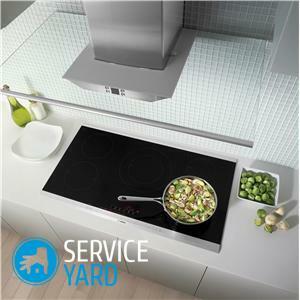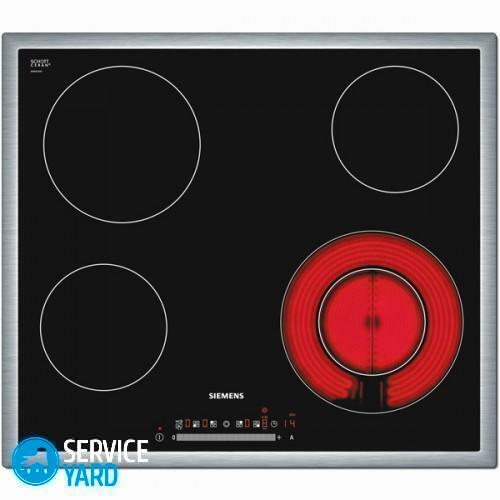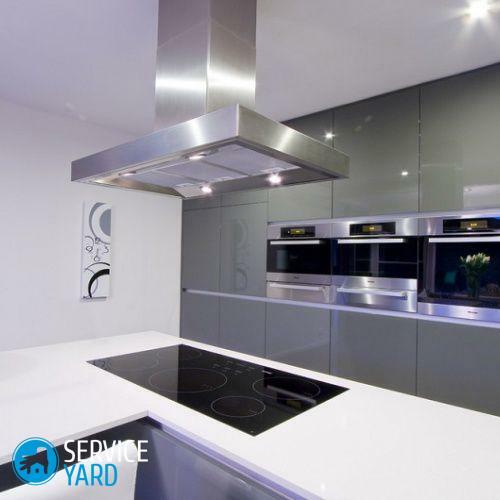
- Glass-ceramic hob
- Induction model
- What kind of utensils can be used for modern panels?
- Which plate should I choose: induction or glass ceramics?
Gas stoves have long ceased to be considered the best option for cooking dishes in the kitchen. The interior of the modern kitchen can not be imagined without hobs built into the furniture. Choose an efficient model for the kitchen stove, and thus equip the kitchen with the latest fashion and modern technology is easy. But to understand what distinguishes the induction hob from the glass ceramic is sometimes difficult. Which is better - glass ceramics or induction cooker, this question we will help to find the answer in this article.
to the contents ↑Glass ceramic hob
Before deciding which plate to choose - induction or glass ceramics, it is worth to learn a little information about the principle of operation, the pros and cons of each option. Let's start with glass ceramics.
99% of induction cooktops are made of glass ceramics, although the plates made of stainless steel sometimes come on sale. For example, V-Zug and Teppan Yaki. In addition, several types of plates with different types of heating automatically fall into the category of glass ceramic surfaces:
- Spiral.
- Halogen( infrared).
- Hi-light.

Thus, the first simple conclusion can be made: the difference between the induction hob and the glass ceramic is that the first concept includes a wider range of options.
Important! Any of the above heating elements is under a coating made of a single sheet of glass-ceramic. The working panel is made of cast-iron discs, with heating elements placed inside. Burners first produce heat, while using the maximum power. After that, the automation switches the operating mode of the plate to a reduced power. After turning off the hob, the temperature is kept for a long time and will remain.
Advantages of ceramic hob panel:
- Attractive appearance.
- Relative cheapness.
- Automatically reduces and increases the heating zone, depending on the size of the bottom of the cookware.
- Burners create an even flow of heat.
- Not the whole surface of the hob is heated, but only the area under the bottom of the cookware.
- The panel displays a residual heat indicator, so if you forget to turn off the hotplate or have not cooled down for a while, the red dot will always remind you about it.
Disadvantages:
- Increased power consumption compared to induction cooker.
- On the glass ceramic surface there are traces of copper and aluminum utensils.
- Often there are chips at the edges of the panel.
- Requires thorough care and constant presence, for example, hot sugar syrup or "runaway" soup can completely ruin the surface material.
- Special tools are required to clean the glass-ceramic surface.
Induction model
The main difference between the induction model is that the plate itself does not warm up. The current flowing through the built-in coils creates a magnetic field and affects the magnetized bottom of the dish. Due to this principle of operation, the electric power is not used for heating the whole cooking surface, but concentrates only in one place.
Important! At presentations of induction models, managers use a very entertaining performance: a pan is put on the panel with water, and chocolate is placed next. While the water in the pan boils, the chocolate is not even going to melt.
Despite the many advantages of the induction panel, it is not always possible to use it. In addition, it should be noted that the created magnetic field affects the microclimate of the room, the work of other household appliances, as well as the well-being of a person.
Important! In connection with the special operating principle of induction cooktops, special utensils having a magnetic bottom are necessary. As a rule, a magnet is included in the kit with the plate, which allows you to check the dishes for suitability.
Advantages of the induction hob:
- High performance with moderate power consumption. Modern induction models of household appliances have high efficiency( from 90%).
- The burners heat up and cool down very quickly. Due to the special heating mechanism, the cooking surface very quickly reaches the desired temperature, so that the cooking process is significantly accelerated.
- Security of use. Since heat is transferred not to the surface of the plate, but only to the dishes, the probability of getting burned by touching the plate is 0. Even children can safely touch the household appliances.
- Does not depend on the voltage in the mains.
- Allows faster heating of one burner at the expense of the second.
- The plate is equipped with automatic switching on and off. As soon as you put the pan - the plate will turn on, remove the dishes - turn off.
- Induction mechanisms do not heat the air, so there is no need to ventilate the room.
- Ease of use.
- Attractive appearance.
- Harmonious combination with any interior details.
- The plate recognizes utensils of only a certain size. If you forget or accidentally drop a spoon on the hob, it will not heat up, since the minimum diameter of the bottom of the dishes can not be less than 12 cm, and in some models - 8 cm.

Important! This feature of the panels slightly complicated the life of coffee lovers, however, there is an output and it is quite simple - purchase an adapter disc.
Disadvantages of the induction model:
- High cost. The price of the model will directly depend on the number of functions of household appliances.
- The need to buy special dishes, which also costs a lot.
- Large loads on wiring.
- Impact of radiation on some things, for example, flash drives, credit cards.
- The complexity of choosing the optimum zone for embedding the panel. Above the metal surfaces induction plates can not be fixed, so you have to think about how to move the oven to another part of the room.
Useful advices for
To not only understand how the induction hob differs from the glass ceramic, but also determine which model is better for you, consider the following:
- Choose an induction panel option with a practical side convenient for you: on the stove there should be at least one large burner.
- Household appliances should be appropriate to the style of the kitchen interior. For example, a black glossy panel without certain contours in the zones of the burners will be appropriate in modern design directions( high-tech), and light hobs with black or red burners will fit well into older interiors.
Which dishes can be used for modern panels?
Once you have decided for yourself, induction or glass-ceramics - which is better, you will have to be puzzled and choosing suitable utensils for a particular plate model:
- All the utensils you will use on electric hobs should have only a flat bottom, without any edgesand depressions.
- For cast iron burners of glass-ceramic panels, it is necessary to select such dishes, the diameter of which will fully correspond to the heating zone. Otherwise, the burners will quickly wear out and waste energy while working.
- For induction models, it is permissible to use pots and pans only with a wide and thick bottom, which possesses ferromagnetic properties. Use it is possible and more thin dishes, but on the bottom there should be special ferromagnetic labels.
- The cookware should be made of metal with magnetic properties, for example, cast iron with enamel coating or stainless steel.
Which plate to choose: induction or glass-ceramics?
When choosing the model of the hob - glass-ceramic or induction, evaluate all the pros and cons of each. The principal difference between them is not very significant:
- The induction panel heats only the bottom of the dishes, and does not take a long time to reach the set temperature. Food that is cooked on such a panel never burns, so the main difference between an induction cooker and a glass ceramic is in a lower consumption of electricity at higher output.
- Glass-ceramic panel with a spiral electrical heating element first heats up itself, and only then begins to heat the dishes.
- Glass-ceramic panel will cost less than induction, in addition, no additional costs for new dishes.
Important! The induction model will please you with a level of safety and absence of an unpleasant smell, while a light smell of burning can always be felt from a plate with a conventional heater.
The choice of model for your kitchen will depend on many criteria, such as:
- Functionality.
- Security.
- Cost-effective.
- Beautiful and refined design.
- Additional functions.
All of the above factors are very important when choosing a hob not only for consumers, but also for manufacturers of new kitchen appliances, which please us with new developments in this area.
Important! Also, select the optimum number of burners, based on the number of family members and the frequency of cooking. Many induction models have not only 4 burners, but also 2, 3 and even 5.
Choosing additional functions of
Modern manufacturers please consumers with the following additional functions of hobs:
- Protection from children.
- Change of power and heating area of burners.
- Sensor control system.
- Ability to set a timer with an alert.
- Programs with memorization of favorite recipes. Some cooktops, thanks to the memory programs, can, if necessary, repeat the selected cooking mode while saving your favorite recipes.
Unlimited number of new and interesting features allows each hostess to choose the most optimal and convenient version of home appliances. When choosing a plate, think about whether you need all the proposed functions, so as not to overpay for those properties that are not necessary. When buying a plate, give preference only to proven brands that have quality certificates. Thanks to the above mentioned advantages and disadvantages of glass-ceramic or induction cookers, we hope that you will be able to choose the optimum option that will not only be the best assistant in the kitchen, but also a stylish addition to the modern interior.
